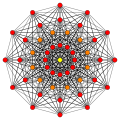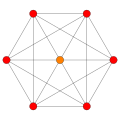| Demiocteract (8-demicube) | |
|---|---|
 Petrie polygon projection | |
| Type | Uniform 8-polytope |
| Family | demihypercube |
| Coxeter symbol | 151 |
| Schläfli symbols | {3,35,1} = h{4,36} s{21,1,1,1,1,1,1} |
| Coxeter diagrams |
|
| 7-faces | 144: 16 {31,4,1} 128 {36} |
| 6-faces | 112 {31,3,1} 1024 {35} |
| 5-faces | 448 {31,2,1} 3584 {34} |
| 4-faces | 1120 {31,1,1} 7168 {3,3,3} |
| Cells | 10752: 1792 {31,0,1} 8960 {3,3} |
| Faces | 7168 {3} |
| Edges | 1792 |
| Vertices | 128 |
| Vertex figure | Rectified 7-simplex |
| Symmetry group | D8, [35,1,1] = [1+,4,36] A18, [27]+ |
| Dual | ? |
| Properties | convex |
In geometry, a demiocteract or 8-demicube is a uniform 8-polytope, constructed from the 8-hypercube, octeract, with alternated vertices removed. It is part of a dimensionally infinite family of uniform polytopes called demihypercubes.
Contents
E. L. Elte identified it in 1912 as a semiregular polytope, labeling it as HM8 for an 8-dimensional half measure polytope.
Coxeter named this polytope as 151 from its Coxeter diagram, with a ring on one of the 1-length branches, ![]()
![]()
![]()
![]()
![]()
![]()
![]()
![]()
![]()
![]()
![]()
![]()
![]() and Schläfli symbol or {3,35,1}.
and Schläfli symbol or {3,35,1}.
Acronym: hocto (Jonathan Bowers) [1]










